11+ SAMPLE HR Contingency Plan
-
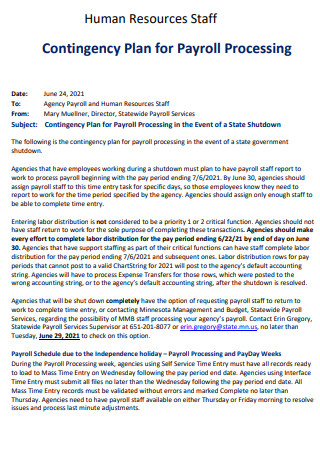
HR Contingency Plan for Payroll Processing
download now -
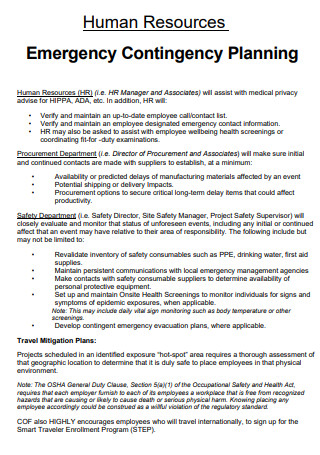
HR Emergency Contingency Plan
download now -
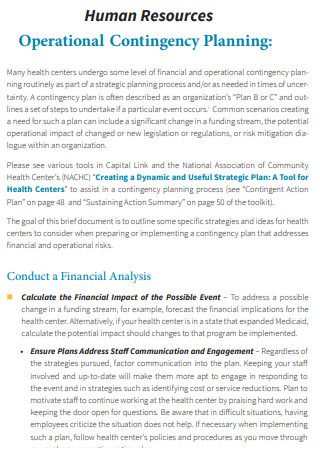
HR Operational Contingency Plan
download now -

Human Resource Risk and Contingency Plan
download now -
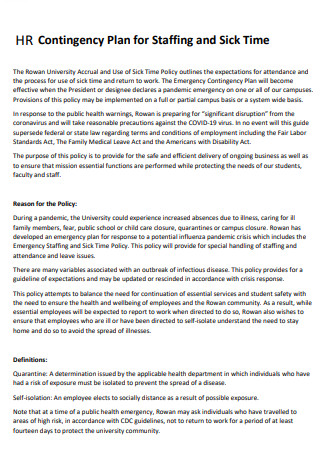
HR Contingency Plan for Staffing and Sick Time
download now -
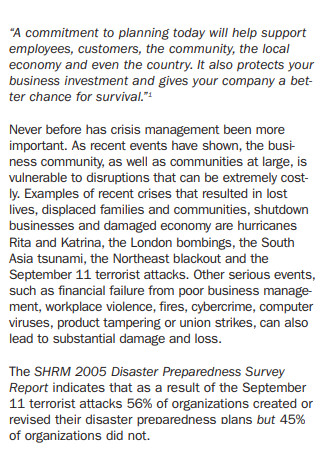
Essential HR Contingency Plan
download now -
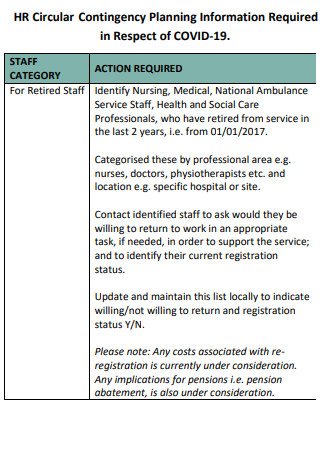
Covid 19 HR Contingency Plan
download now -
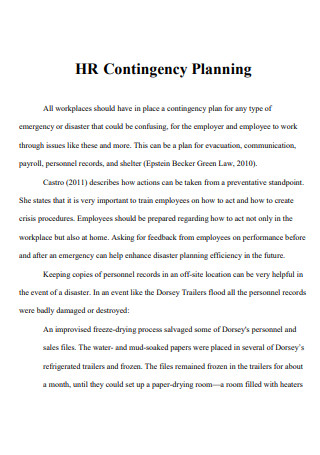
HR Contingency Plan Template
download now -
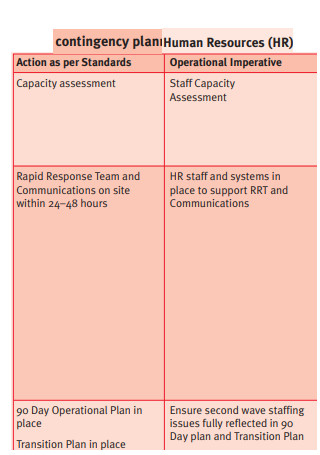
General HR Contingency Plan
download now -
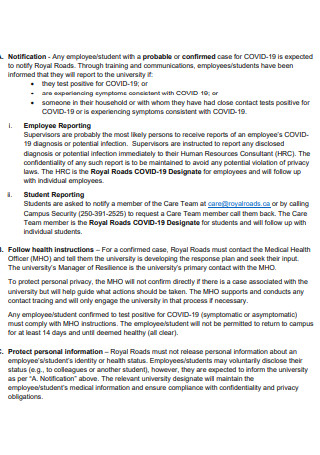
Professional HR Contingency Plan
download now -
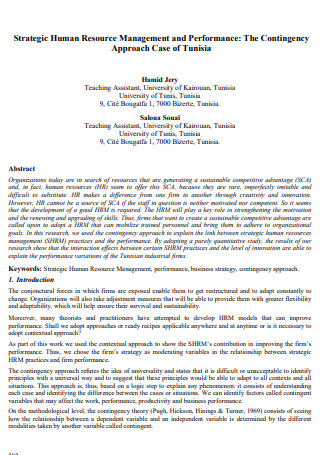
HR Contingency Strategic Plan
download now -

HR Contingency Plan in PDF
download now
FREE HR Contingency Plan s to Download
11+ SAMPLE HR Contingency Plan
What Is an HR Contingency Plan?
Employee-related Events That Necessitate an HR Contingency Plan
Benefits of An HR Contingency Plan
How To Make an HR Contingency Plan
FAQS
Why Do We Need a Contingency Plan?
Are Natural Disasters Part of an HR Contingency Plan?
When Do We Start Implementing the Contingency Plan?
What Is an HR Contingency Plan?
A Human Resource Contingency Plan is a written descriptive plan of action designed to successfully cope with any situation that hinders an employee from performing their job. A contingency plan is essential for keeping a business or company going normally. It should be part of an HR strategic plan as well as an HR action plan to an emergency. A company that is unable to run at full capacity due to an employee may pose some difficulties. Project delays, financial loss, and inefficiency are examples of such risks. That is why it is critical to have a contingency plan for the HR department in place.
A contingency plan examines a potential occurrence and recommends the best course of action. Given that definition, an HR contingency plan should be a course of action that would effectively deal an incident with appropriate response. It also aids business continuity by preventing excessive losses or escalation. It’s a preventative action plan.
Employee-related Events That Necessitate an HR Contingency Plan
Almost all an HR contingency plan is concerned with the implications of an employee’s inability to perform their existing duties. Events that could influence an employee’s productivity. Situation that was not necessarily a planned development. An HR contingency plan is part of a workplace emergency action plan that allows work operations to continue. And here are some scenarios that may demand a human resource department contingency plan.
Benefits of An HR Contingency Plan
Contingency plans are created when there are observable or projected risks. But it is never implemented until the event occurs. And, clearly, no one wanted it to be utilized. However, having a backup plan provides everyone some peace of mind. It allows people to gather their thoughts and recover after an event. So, why look for contingency plan examples? Of certainly, because of the benefits it provides.
How To Make an HR Contingency Plan
We have outlined events that may demand a contingency plan, as well as the benefits of doing so. It is now time to learn how to create one without relying on a HR contingency plan template. Nonetheless, it is also simpler to use a HR contingency plan example as a guide for developing one. But first, let’s go through what a contingency plan is and how to create one.
Tip 1: Identify the Risks
Before you begin drafting a contingency plan, you must first identify potential risk involved. The possibilities would aid in narrowing down the course of action that should be taken. It’s also a good idea to figure out how serious these problems are. Their significance may influence how quickly an action should be taken. These dangers can range from employee-related incidents to natural disasters. It is anything that poses a risk to a company’s operations.
Tip 2: Identify the Impact
So, once you’ve recognized the concerns, figure out how they’ll affect the business. It aids in the creation of a priority list in the strategy. The impact should include everything from employee well-being to a company’s operational and financial loss. The impact of the risk on the company varies. As a result, the solution and steps would have to differ as well. There are nuances that can have a larger influence and should be prioritized.
Tip 3: Course of Action
Following an evaluation of the potential consequences of these risks, the next step is to determine a course of action. Make a list of viable ideas that can be practically realized. The steps that must be followed should be clear and straightforward. It should be simple to understand and implement. As far as possible, avoid using jargon. The action plan should also be reasonable. It should not be ambiguous or obtuse. It should be clearly related to its intended function.
Tip 4: Define a Time Period
When doing these measures, it is critical to consider the timing. Timing is critical in minimizing loss. If there is a waiting period, make a note of it. If immediate action is required, highlight it. In this manner, the contingency plan may be efficiently implemented. There should be a time limit before irreversible damage occurs. It also serves to stress the gravity of the issue. It also allows for some breathing room before taking action. Creating a timeline assists in establishing a list of prioritized actions to be performed.
Tip 5: Assign Responsibilities
It is critical to appoint selected persons to take on the responsibility. Their major job is to provide direction. As a result, they have information about the course of action to be pursued. And it is up to these employees to put the contingency plan into action. Assigning responsibilities aids in the management of stress. It also permits a more knowledgeable person to take control of the situation. These individuals aid in maintaining charge of the situation and preventing it from escalating.
FAQS
Why Do We Need a Contingency Plan?
Contingency plans enable a firm or company to maintain operations. That is, amid a continuing or concluded incident. These are occurrences that have the potential to halt or disrupt the flow of work. Contingency plans aid in the reduction of cost significantly and the rapid recovery of resources.
Are Natural Disasters Part of an HR Contingency Plan?
Typically, the HR department is in charge of responding to emergencies and disasters. So, yeah, natural calamities are still on the list of contingencies. There are numerous contingency plans that address various eventualities.
When Do We Start Implementing the Contingency Plan?
The timing and method of putting the contingency plan into action differs. It is determined by the gravity of the situation. There is no need to implement it if a situation recovers on its own before any damage can occur. However, if an occurrence necessitates quick action, it must also be carried out immediately. That is why identifying the effect and severity of the risks is part of the contingency plan. This is to assist establish a priority and time range before enacting a contingency plan.
As an HR personnel, start thinking about contingency measures. It not only allows for a quick recovery, but it also helps to minimize loss. Begin your contingency planning by getting HR contingency plan pdfs and sample HR contingency plans!
